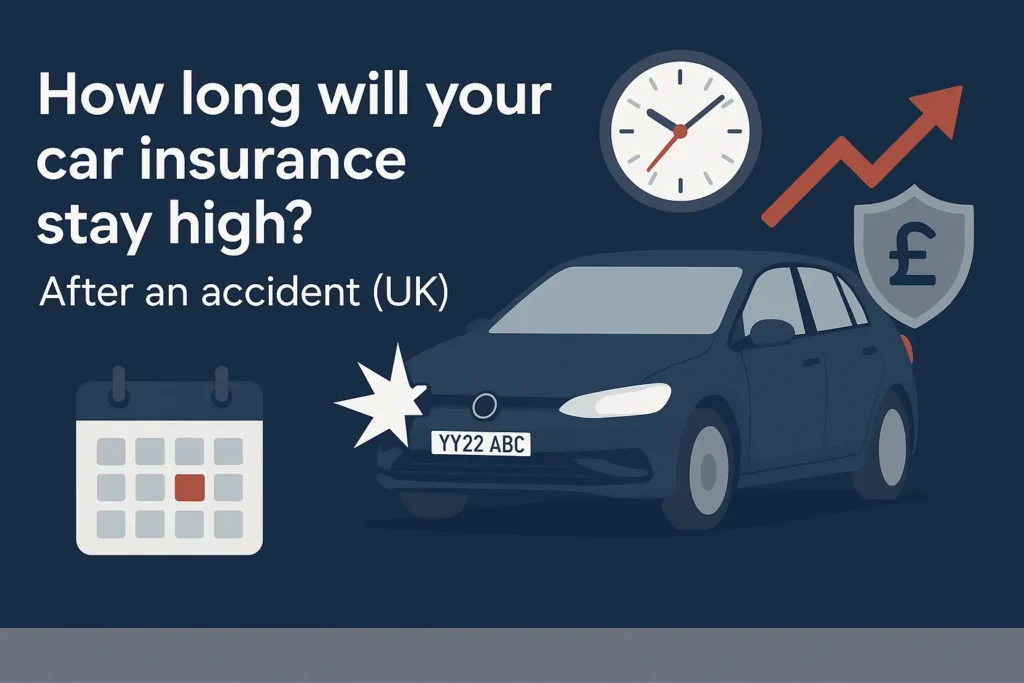
How Long Does Car Insurance Stay High After an Accident in the UK?
If you’ve recently had a car accident, you may notice your insurance premium has increased — sometimes by hundreds of pounds. This is completely normal, as insurers view drivers who have made a claim as more likely to make another in the future. But how long does it last, and can you reduce it sooner?
In this guide, we’ll explain how long your car insurance remains high after an accident in the UK, what factors affect this period, and the steps you can take to lower it faster in 2025.
How Long Do Insurance Premiums Stay High After an Accident?
In most cases, your car insurance premium stays higher for **three to five years** after an at-fault accident. During this time, insurers take your previous claims into account when calculating renewal quotes.
- First year after accident: Premium typically increases 20–40%
- After 2 years: The impact gradually reduces if no further claims are made
- After 3–5 years: Many insurers stop considering the accident for pricing
The exact duration depends on your insurer, the claim amount, and whether the accident was your fault.
At-Fault vs Non-Fault Accidents: What’s the Difference?
Even if an accident wasn’t your fault, your premium can still rise. This happens because insurers see you as statistically more likely to be involved in another claim.
At-fault accident: You (or your insurer) paid for the damage. Premium impact: **High**.
Non-fault accident: Another driver was responsible. Premium impact: **Moderate**.
Always ensure your insurer records the correct “fault status”. If they wrongly mark a non-fault accident as at-fault, you could overpay for years.
Why Does Car Insurance Go Up After an Accident?
- Statistically higher risk of future claims.
- Loss of No Claims Bonus (NCB).
- Higher administrative and reinsurance costs for your insurer.
Most insurers use algorithms that heavily penalise recent claims. The good news: the penalty reduces with every claim-free year.
How to Reduce High Insurance Premiums After an Accident
1. Protect or Rebuild Your No Claims Bonus
NCB is one of the biggest premium factors. If you didn’t protect it before your claim, focus on rebuilding it by staying claim-free for 12+ months. Some insurers allow you to transfer partial NCB even after an accident.
2. Compare Quotes from Specialist Insurers
Many standard comparison sites reject post-accident profiles. Instead, use specialist UK high-risk insurers who manually review claims history. You can often save up to 25% this way.
3. Avoid Making Small Claims
If repairs cost less than your excess, pay out of pocket. Making small claims can cost more long-term in lost discounts.
4. Choose a Higher Voluntary Excess
Opting for a higher voluntary excess (e.g., £300–£500) lowers your base premium, but make sure it remains affordable if you claim again.
5. Drive Safely and Use Telematics
Telematics or “black box” insurance tracks your driving habits. Safe driving scores can restore insurer confidence and gradually lower premiums each renewal.
When Will My No Claims Discount Recover?
If your NCB was lost due to an at-fault accident, it typically takes **five consecutive claim-free years** to rebuild fully. Many high-risk insurers offer NCB protection after your first renewal.
Average UK Premiums After an Accident (2025)
Based on recent market averages, here’s how insurance costs compare:
| Claim Type | Average Annual Premium (UK, 2025) |
|---|---|
| No claims in 5 years | £680 |
| 1 non-fault claim (past 12 months) | £890 |
| 1 at-fault claim (past 12 months) | £1,220 |
| 2 at-fault claims (past 3 years) | £1,800+ |
Even one claim can raise your premium 30–50%. However, the impact drops each year you remain claim-free.
How Insurers View Claim Frequency
Insurers care less about the severity of an accident and more about frequency. Two small claims can sometimes raise premiums more than one large claim. Always evaluate whether it’s worth claiming minor damages.
Tips for Faster Premium Recovery
- Shop around every renewal — never auto-renew.
- Switch to insurers specialising in post-accident drivers.
- Pay annually, not monthly.
- Keep your record clean for 3–5 years.
- Install a dash cam — some insurers offer discounts.
Final Thoughts
Your insurance won’t stay high forever after an accident. Most drivers start seeing normalised rates within three years, especially with good driving behaviour and specialist support. Comparing high-risk car insurance options in the UK remains the most effective way to cut costs faster.
See also our guide on car insurance after an accident for more details on managing renewals and claims.
Frequently Asked Questions
How long does car insurance stay high after an accident in the UK?
Usually between 3–5 years, depending on the insurer and fault type. Rates gradually improve with claim-free renewals.
Will my premium go up after a non-fault accident?
It can increase slightly because you’re statistically more likely to claim again, even if the accident wasn’t your fault.
How can I lower my premium faster after an accident?
Stay claim-free, compare quotes from specialist high-risk insurers, and consider telematics or advanced driver courses.
Can I protect my No Claims Bonus after an accident?
Yes. Some insurers offer partial NCB protection or allow you to rebuild faster with accident forgiveness schemes.
